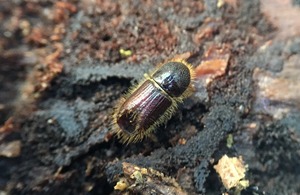New restrictions to limit impact of Ips typographus tree pest
Spruce tree planting prohibited in parts of East Anglia and South East England

Planting of spruce trees in parts of East Anglia and South East England is to be restricted as part of additional new measures announced by the Forestry Commission today (Tuesday 8 October) following further findings this season of Ips typographus, also known as the eight-toothed spruce bark beetle.
A new spruce tree planting restriction is coming into force in the restricted area, known as the Demarcated Area (DMA). Landowners, businesses and land managers are urged to comply with new requirements and stay vigilant to protect against Ips typographus. Planting spruce trees for ornamental and scientific purposes, growing on nursery sites for trade, or the planting of Christmas trees, will be permitted in specific circumstances detailed in the notice. Christmas tree growers in the affected area can continue to grow an unlimited number of spruce trees up to three metres in height above the root collar before authorisation is required.
The new restrictions come after further findings this year, including the first UK finding of Ips typographus on Sitka spruce in July, and are part of the continued action being taken to limit the spread of the beetle and protect our nation’s trees, forestry and timber industries.
Ips typographus is a serious pest of spruce trees in Europe and was first identified in the UK in 2018. These incursions are occurring in England as the beetle is blown over from the continent. The pest prefers stressed or dying trees but, under the right conditions, it can attack healthy trees.
The new requirements come into force on 29 October across the existing DMA in the South East of England and East Anglia prohibiting the planting of spruce trees (Picea A.Dietr). Areas affected include parts of Lincolnshire, Bedfordshire, Cambridgeshire, Norfolk, Suffolk, Hampshire, Berkshire, Buckinghamshire, Hertfordshire, Surrey, Greater London, Sussex, Kent and Essex.
Forestry Commission Head of Plant Health Forestry Andrea Deol said:
Ips typographus can have a serious impact on spruce trees, and so restricting spruce planting in some areas of East and South East England ahead of the tree-planting season will help with our ongoing eradication efforts.
All landowners, managers and timber processors are encouraged to remain vigilant and report any sightings of the pest via our Tree Alert Portal.
Defra Chief Plant Health Officer Professor Nicola Spence said:
Pest and pathogens present a great risk for our biosecurity and, in particular, Ips typographus has the potential to cause significant damage to Great Britain’s forestry and timber industries.
These new restrictions are part of continued action to limit the spread of the beetle and protect our nation’s trees and forest industries. All landowners and land managers should check the health of spruce trees on their land and take swift action to deal with any susceptible material.
Existing restrictions remain in place to limit the spread of the pest through timber movement, by requiring pre-notification and authorisation by the Forestry Commission of any felling and movement of susceptible material within the DMA.
It is important for landowners to continue to check the health of spruce trees on their land, identifying stressed, fallen, and snapped trees, and taking action to remove them and any surrounding susceptible material. Replacement with non-susceptible tree species is also encouraged to limit the possibility of populations of Ips typographus establishing and to prevent spread to other areas.
Under the notice, exemptions are available for lower risk scenarios, such as trees grown at nurseries, for ornamental or scientific purposes and for the purpose of trade in Christmas trees.
Any sightings should be reported to the Forestry Commission via the TreeAlert online portal. Read the full guidance on the new requirements.
Additional information:
A video is available explaining the threat of Ips typographus on spruce trees in the UK, with advice on how woodland owners can help reduce the risk from this pest:
- The requirement will be enforced for any trees from the genus Picea A.Dietr.
-
An infographic is available explaining the spruce planting prohibition for different industry groups
- Any suspected findings of the beetle can be reported using the online portal TreeAlert.
-
Support is available through the Tree Health Pilot which provides funding for landowners to remove spruce in the Proactive Spruce Removal Area
- An updated Outbreak Sites Summary Map is available via this link.
- Further information on why biosecurity is important in preventing the introduction and spread of pests and pathogens, is now available on the Forest Research Climate Change Hub. Landowners and managers can find a step-by-step guide to developing a Biosecurity Action Plan, including tips on how to carry out biosecurity measures. The Climate Change Hub brings together information and practical guidance about protecting UK woodlands and forests from the impacts and risks due to the changing climate through adaptive practice.